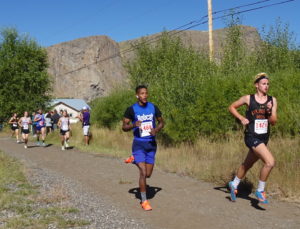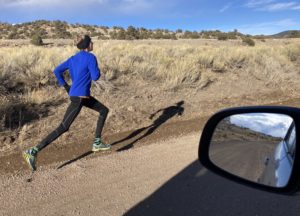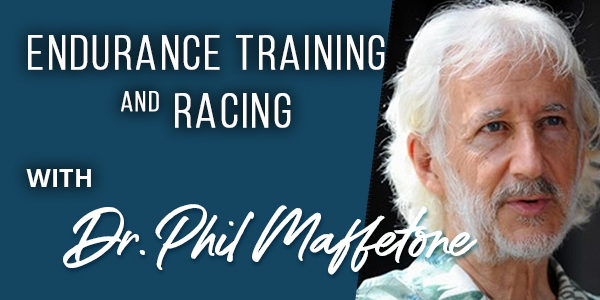
Visualization, photographic memory and running form
There’s no question running efficiency is the key to going faster with less effort, and — usually — less chance of injury. However, running form is individual and it’s very important to find a gait that works naturally with your body’s own biomechanics and fitness level.
As Dr. Phil Maffetone notes, there is no single “gait” that works for every individual, nor in every circumstance — including different distances, surfaces and terrains. However, some basic principles apply to proper running form. Generally, it’s best to avoid heel-striking, while landing with knees slightly bent, body slightly forward, shoulders back and chest open.
While this may sound complicated, it’s actually quite simple and your brain is in charge. When you are running with correct form everything seems to fall into place.
“The brain controls it all,” Dr. Maffetone says. “It’s up to you to give it the right input for the best results — this includes great nutrition and appropriate footwear, as well as proper physical and mental training.
“Running requires balancing a complex combination of many brain areas to sense and send messages to muscles and other structures throughout the body to create the proper gait — one that functions within the ability of the individual’s level of health and fitness.”
As a competitive runner and coach I’ve had the chance to see hundreds of top-level runners in action over the course of four decades, while also experiencing the evolution of my own MAF 180 gait.
In recent years I’ve had the great fortune to coach two top-level high-school runners who were born in Ethiopia, as well as a number of other athletes of all abilities including my own son Harrison who is on the autism spectrum.
Elias and Micah Zeller were adopted from Ethiopia at a young age by a local family here in Westcliffe, Colorado, where I live and coach cross-country and track at an altitude of 8,000 feet. Harrison is also on the varsity cross-country and track team.
Elias’ and Micah’s running gaits are among the best I’ve ever seen, which is really something considering Olympic marathon gold medalist Frank Shorter ran almost daily past my dorm room at the University of Colorado in Boulder.
In fact, a study published in the Journal of Sports Physiology and Performance found that among several characteristics, what helps make East African runners, particularly those from Ethiopia and Kenya, so great is the “development of good metabolic “economy/efficiency” based on somatotype and lower limb characteristics.” Some of this, according to the study, can be attributed to genetic predisposition, and development of a high maximal oxygen uptake as a result of extensive walking and running at an early age — often barefoot. In addition, altitude, diet, skeletal muscle composition, and other factors contribute to the excellence common to many East African runners.
The abilities of Ethiopian distance runners also are explored in the recent book, Out of Thin Air: Running Wisdom and Magic from Above the Clouds in Ethiopia, by anthropologist Michael Crawley.

Elias competing as an unattached runner in the Mountaineer-Cowboy collegiate meet in Gunnison, Colorado, 2019.
From the first time I ever saw Elias and Micah run, there was a picture in my mind that this is what running in its purest form should look like. Ultimately, Micah had a stellar senior year this past cross-country season, winning several meets and placing second in the 2A Colorado State Cross Country Championship. He recently signed a scholarship deal to run at a NCAA Division II university.
While Ethiopian and Kenyan runners are famous for their success at middle to long distances, there’s no question running efficiency has a direct effect on overall times, regardless of how far you run. By the way, Micah has tripped the town’s digital school zone speed-limit sign at 21 mph for a short distance!
I’ve also noticed that in many athletes other distractions can affect gait — the mind has a powerful influence over how well or poorly you run. A bad day at school or an argument with parents could result in a stride that’s all over the place. It’s no secret that almost all gaits deteriorate with mental and physical fatigue — this is one reason I never hammer runners I coach with a excessive speed work — they get tired and their gait goes right down the drain. At some point you are actually training them to run with poor form.
I have many other kids to coach as well, and one of these happens to be Harrison, also known as “The Blur,” not entirely because of his running — there’s a fuzzy boundary sometimes between his reality and the rest of ours. Such is the perspective of people on the autism spectrum. But one thing that is not blurry about him is his ability to retain an image in his mind for a very long time — a photographic memory.
While all kids’ mental state can affect running gait, Harrison’s is very dramatic. If things are a mess in his head, his legs and feet seem to expend more energy traveling any direction other than forward. However, when things are firing correctly, he actually has pretty good form. And why wouldn’t he? For several years he’s been running with two very good mental imagery models in Elias and Micah — and autistic people are visual thinkers. (Music helps too. Check out our previous article about Harrison.)
With Elias heading off to college last year, and Micah in his senior year now, one focus as Harrison’s coach is attempting to improve his running form with imagery of his Ethiopian teammate. However, with one caveat — he needs to blend some of Micah’s form with his own. We’re working on the foot strike, spring, and follow-through.

Kidus Begashaw (left) and Micah Zeller going through mile 1 in sub 4:50 at the Colorado State 2A Championships. Both are Ethiopian. Kidus placed first and Micah second.
Used appropriately, mental imagery can help many people perform better. However, overthinking can produce what Dr. Maffetone calls an “illusion injury.” He notes that when he was in private practice he often saw a rise in injured runners following televised marathon events such as the New York City and Boston marathons.
Obviously, there is a limit to how far you can take mental imagery. Another thing to consider is just how long or far a runner can maintain a certain gait or stride. This may be limited by fitness or purely by biomechanics. If making mental modifications to your gait results in something not sustainable over the course of a usual training run or race distance — or worse, causes pain beyond slight transient discomfort — then you need to re-evaluate.
Visualization can be accomplished through training with runners with good gaits, as discussed by Crawley in his book, as well as photographs and video. I sometimes have Harrison and my other runners watch Micah run and think about what they can incorporate into their own natural styles. If you are heel-striking, can you land more mid-foot? If you are pausing with each strike can you spring your foot up more quickly?
For Harrison, it’s been especially effective to show him a picture or video of himself running with good form. I’ve also recently added “truck-training” workouts to his off-season routine. I can video him running while driving alongside. I’m hoping to see the results in track season this spring, and his senior year of cross-country, starting next fall.
Improving your running gait can help you go faster and farther with less effort and with reduced risk of injury. While very few runners are blessed with perfect form, focusing on better brain function along improving your natural stride can help you get the most from your training and racing.









